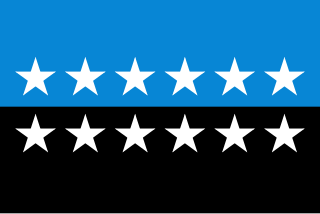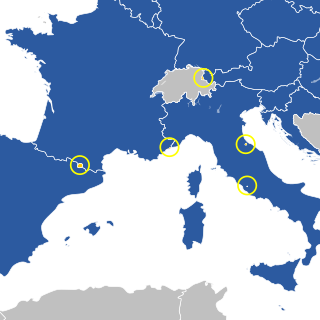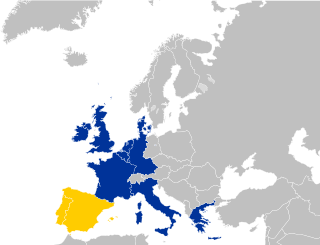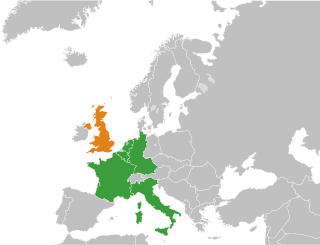
 President Rey
President Rey Term: 1967-1970 Party: LDR
The Rey Commission is the European Commission that held office from 2 July 1967 to 30 June 1970. Its president was Jean Rey.

 President Rey
President Rey The Rey Commission is the European Commission that held office from 2 July 1967 to 30 June 1970. Its president was Jean Rey.

It was the first commission of the merged European Communities. It was the successor to the Hallstein Commission and was succeeded by the Malfatti Commission. The commission worked to reinforce the Communities' institutions and increase the powers of the European Parliament. It also campaigned for an elected parliament, which was achieved later in 1979. It oversaw the competition of the customs union in 1968. [1]
Rey played an important role the Summit of The Hague in 1969, where the European leaders decided to relaunch European integration with two new initiatives: on the one hand, Economic and Monetary Union of the European Union (EMU), and on the other hand, European Political Cooperation (EPC), which foreshadow the euro and the Common Foreign and Security Policy of the European Union today.
Finally, in 1970, the last year of this mandate, Rey managed to win the European governments' support for his proposal to give the Community "own resources". This meant that the EEC no longer depended exclusively on contributions by the member states, but could complete these with revenues from customs duties, levies on agricultural products from outside the EEC, in addition to a share of the VAT revenue.
The commission was composed of 14 members, 3 from Italy, West Germany, and France, 2 from Belgium and the Netherlands and 1 from Luxembourg.
The colour of the row indicates the approximate political leaning of the office holder using the following scheme:
| Affiliation | No. of Commissioners |
|---|---|
| Right leaning / Conservative | 8 |
| Liberal | 2 |
| Left leaning / Socialist | 4 |

The European Union (EU) is a supranational political and economic union of 27 member states that are located primarily in Europe. The Union has a total area of 4,233,255 km2 (1,634,469 sq mi) and an estimated total population of over 448 million. The EU has often been described as a sui generis political entity combining the characteristics of both a federation and a confederation.

The European Coal and Steel Community (ECSC) was a European organization created after World War II to integrate Europe's coal and steel industries into a single common market based on the principle of supranationalism which would be governed by the creation of a High Authority which would be made up of appointed representatives from the member states who would not represent their national interest, but would take and make decisions in the general interests of the Community as a whole. It was formally established in 1951 by the Treaty of Paris, signed by Belgium, France, Italy, Luxembourg, the Netherlands, and West Germany and was generally seen as the first step in the process of European integration following the end of the Second World War in Europe. The organization's subsequent enlargement of both members and duties ultimately led to the creation of the European Union.

The European Economic Community (EEC) was a regional organisation created by the Treaty of Rome of 1957, aiming to foster economic integration among its member states. It was subsequently renamed the European Community (EC) upon becoming integrated into the first pillar of the newly formed European Union in 1993. In the popular language, however, the singular European Community was sometimes inaccurately used in the wider sense of the plural European Communities, in spite of the latter designation covering all the three constituent entities of the first pillar.

The European Commission (EC) is part of the executive of the European Union (EU). It operates as a cabinet government, with 27 members of the Commission headed by a President. It includes an administrative body of about 32,000 European civil servants. The commission is divided into departments known as Directorates-General (DGs) that can be likened to departments or ministries each headed by a Director-General who is responsible to a Commissioner.

The president of the European Commission is the head of the European Commission, the executive branch of the European Union (EU). The president of the commission leads a cabinet of commissioners, referred to as the college. The president is empowered to allocate portfolios among, reshuffle, or dismiss commissioners as necessary. The college directs the commission's civil service, sets the policy agenda and determines the legislative proposals it produces. The commission is the only body that can propose or draft bills to become EU laws.

The European Communities Act 1972, also known as the ECA 1972, was an act of the Parliament of the United Kingdom which made legal provision for the accession of the United Kingdom as a member state to the three European Communities (EC) – the European Economic Community, European Atomic Energy Community (Euratom), and the European Coal and Steel Community ; the EEC and ECSC subsequently became the European Union.

Jean Rey was a Belgian Liberal politician who served as the second president of the European Commission from 1967 to 1970. He served as European Commissioner for External Relations from 1958 to 1967. The 1983–1984 academic year at the College of Europe was named in his honour.

Walter Hallstein was a German academic, diplomat and statesman who was the first president of the Commission of the European Economic Community and one of the founding fathers of the European Union.

The European Union (EU) has expanded a number of times throughout its history by way of the accession of new member states to the Union. To join the EU, a state needs to fulfil economic and political conditions called the Copenhagen criteria, which require a stable democratic government that respects the rule of law, and its corresponding freedoms and institutions. According to the Maastricht Treaty, each current member state and the European Parliament must agree to any enlargement. The process of enlargement is sometimes referred to as European integration. This term is also used to refer to the intensification of co-operation between EU member states as national governments allow for the gradual harmonisation of national laws.
European integration is the process of industrial, economic, political, legal, social, and cultural integration of states wholly or partially in Europe, or nearby. European integration has primarily but not exclusively come about through the European Union and its policies.
The European Monetary System (EMS) was a multilateral adjustable exchange rate agreement in which most of the nations of the European Economic Community (EEC) linked their currencies to prevent large fluctuations in relative value. It was initiated in 1979 under then President of the European Commission Roy Jenkins as an agreement among the Member States of the EEC to foster monetary policy co-operation among their Central Banks for the purpose of managing inter-community exchange rates and financing exchange market interventions.
The Hallstein Commission is the European Commission that held office from 7 January 1958 to 30 June 1967. Its president was Walter Hallstein and held two separate mandates.

Currently, all of the European microstates have some form of relations with the European Union (EU).

The history of the European Communities between 1958 and 1972 saw the early development of the European Communities. The European Coal and Steel Community (ECSC) had just been joined by the European Atomic Energy Community (Euratom) and the European Economic Community (EEC), the latter of which soon became the most important. In 1967 the EEC's institutions took over the other two with the EEC's Commission holding its first terms under Hallstein and Rey.

This is a timeline of European Union history and its previous development.
The snake in the tunnel was a system of European monetary cooperation in the 1970s which aimed at limiting fluctuations between different European currencies. It was the first attempt at European monetary cooperation. It attempted to create a single currency band for the European Economic Community (EEC), essentially pegging all the EEC currencies to one another.

Spain and Portugal acceded to the European Communities, now the European Union, in 1986. This was the third enlargement of the Communities, following on from the 1973 and 1981 enlargements. Their accessions are considered to be a part of the broader Mediterranean enlargement of the European Union.

The accession of the United Kingdom to the European Communities (EC) – the collective term for the European Coal and Steel Community (ECSC), the European Economic Community (EEC) and the European Atomic Energy Community (EAEC) – took effect on 1 January 1973. This followed ratification of the Accession treaty which was signed in Brussels on 22 January 1972 by the Conservative prime minister Edward Heath, who had pursued the UK's application to the EEC since the late 1950s. The ECSC and EEC would later be integrated into the European Union under the Maastricht and Lisbon treaties in the early 1990s and mid-2000s.

The United Kingdom was a member state of the European Union (EU) and of its predecessor the European Communities (EC) – principally the European Economic Community (EEC) from 1 January 1973 until 31 January 2020. Since the foundation of the EEC, the UK had been an important neighbour and then leading member state, until Brexit ended 47 years of membership. During the UK's time as a member state two referendums were held on the issue of its membership, with the first being held on 5 June 1975, resulting in a vote to stay in the EC, and the second, held on 23 June 2016, which resulted in the vote to leave the EU.

The Bruges speech was given by British prime minister Margaret Thatcher to the College of Europe at the Belfry of Bruges, Belgium, on 20 September 1988. Thatcher was opposed to any moves to transition the European Economic Community (EEC) into a federal Europe that would take powers away from its members. She considered European Commission president Jacques Delors a campaigner for federalisation and clashed with him publicly. Earlier in 1988, Delors had reaffirmed his commitment for the EEC to take a greater role in establishing European economic, fiscal and social legislation, which Thatcher considered provocative. On 8 September, Delors spoke to Britain's Trades Union Congress, calling for their support.